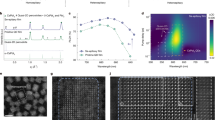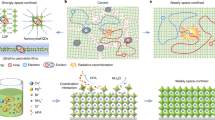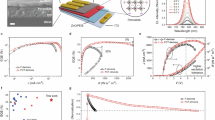Abstract
Metal-halide perovskites are promising light-emitter candidates for next-generation light-emitting diodes (LEDs)1,2,3,4,5,6,7,8. Achieving high brightness and efficiency simultaneously in pure-red perovskite LEDs (PeLEDs) is an ongoing goal9,10. Three-dimensional (3D) CsPbI3-xBrx emitters have excellent carrier transport capability and high colour purity, which could allow efficient and ultrabright pure-red PeLEDs. However, such devices are prone to efficiency roll-off, resulting in low efficiency and low brightness under high current density. Here, by using electrically excited transient absorption spectroscopy, we discovered the efficiency roll-off was induced by hole leakage. Therefore, we developed a CsPbI3-xBrx intragrain heterostructure containing narrow bandgap emitters and wide bandgap barriers to confine the injected carriers. The wide bandgap barrier was incorporated by introducing strongly bonding molecules into the [PbX6]4− framework to expand the 3D CsPbI3-xBrx lattice. This strategy resulted in bright and efficient pure-red PeLEDs, with a high brightness of 24,600 cd m−2, maximum external quantum efficiency of 24.2% and low efficiency roll-off, maintaining a 10.5% external quantum efficiency at a high luminance of 22,670 cd m−2.
This is a preview of subscription content, access via your institution
Access options
Access Nature and 54 other Nature Portfolio journals
Get Nature+, our best-value online-access subscription
27,99 € / 30 days
cancel any time
Subscribe to this journal
Receive 51 print issues and online access
199,00 € per year
only 3,90 € per issue
Buy this article
- Purchase on SpringerLink
- Instant access to full article PDF
Prices may be subject to local taxes which are calculated during checkout




Similar content being viewed by others
Data availability
The data that support the findings of this study are available in the article and its Supplementary Information. All other relevant data are available from the corresponding authors. Source data are provided with this paper.
Code availability
The computational codes and associated software, encompassing details on access, installation and execution procedures, as well as the necessary input files (including atomic structures and parameters) and output files for both initial processing and post-processing, are available from the corresponding authors.
References
Yuan, M. et al. Perovskite energy funnels for efficient light-emitting diodes. Nat. Nanotechnol. 11, 872–877 (2016).
Tan, Z. K. et al. Bright light-emitting diodes based on organometal halide perovskite. Nat. Nanotechnol. 9, 687–692 (2014).
Lu, M. et al. Metal halide perovskite light-emitting devices: promising technology for next-generation displays. Adv. Funct. Mater. 29, 1902008 (2019).
Sun, Y. et al. Bright and stable perovskite light-emitting diodes in the near-infrared range. Nature 615, 830–835 (2023).
Lin, K. et al. Perovskite light-emitting diodes with external quantum efficiency exceeding 20 percent. Nature 562, 245–248 (2018).
Kim, J. S. et al. Ultra-bright, efficient and stable perovskite light-emitting diodes. Nature 611, 688–694 (2022).
Cao, Y. et al. Perovskite light-emitting diodes based on spontaneously formed submicrometre-scale structures. Nature 562, 249–253 (2018).
Guo, B. et al. Ultrastable near-infrared perovskite light-emitting diodes. Nat. Photon. 16, 637–643 (2022).
Han, T.-H. et al. A roadmap for the commercialization of perovskite light emitters. Nat. Rev. Mater. 7, 757–777 (2022).
Hassan, Y. et al. Ligand-engineered bandgap stability in mixed-halide perovskite LEDs. Nature 591, 72–77 (2021).
Li, H. et al. Nanosurface-reconstructed perovskite for highly efficient and stable active-matrix light-emitting diode display. Nat. Nanotechnol. 19, 638–645 (2024).
Kong, L. et al. Fabrication of red-emitting perovskite LEDs by stabilizing their octahedral structure. Nature 631, 73–79 (2024).
Wang, Y.-K. et al. Long-range order enabled stability in quantum dot light-emitting diodes. Nature 629, 586–591 (2024).
Zhao, F. et al. Iodotrimethylsilane as a reactive ligand for surface etching and passivation of perovskite nanocrystals toward efficient pure-red to deep-red LEDs. Angew. Chem. Int. Ed. 62, e202311089 (2023).
Liu, X. K. et al. Metal halide perovskites for light-emitting diodes. Nat. Mater. 20, 10–21 (2021).
Fakharuddin, A. et al. Perovskite light-emitting diodes. Nat. Electron. 5, 203–216 (2022).
Protesescu, L. et al. Nanocrystals of cesium lead halide perovskites (CsPbX3, X = Cl, Br, and I): novel optoelectronic materials showing bright emission with wide color gamut. Nano Lett. 15, 3692–3696 (2015).
Zeng, J. et al. Switchable interfacial reaction enables bright and stable deep-red perovskite light-emitting diodes. Nat. Photon. 18, 325–333 (2024).
Wang, K. H. et al. High quality CsPbI3-xBrx thin films enabled by synergetic regulation of fluorine polymers and amino acid molecules for efficient pure red light emitting diodes. Adv. Opt. Mater. 9, 2001684 (2020).
Andaji-Garmaroudi, Z. et al. Elucidating and mitigating degradation processes in perovskite light-emitting diodes. Adv. Energy Mater. 10, 2002676 (2020).
Liu, P. et al. Quasi-2D CsPbBrxI3-x composite thin films for efficient and stable red perovskite light-emitting diodes. Adv. Opt. Mater. 9, 2101419 (2021).
Song, Y.-H. et al. Planar defect-free pure red perovskite light-emitting diodes via metastable phase crystallization. Sci. Adv. 8, eabq2321 (2022).
Li, B., Tang, B. & Fan, F. Transient absorption spectrometer using excitation by pulse current. PCT patent WO2022121082A1 (2022).
Li, B., Tang, B. & Fan, F. Transient absorption spectrometer using excitation by pulse current. CN patent CN112683797B (2021).
Li, B. et al. Origin of the efficiency roll-off in quantum dot light-emitting diodes: an electrically excited transient absorption spectroscopy study. Nano Lett. 24, 10650–10655 (2024).
Haus, J. W., Zhou, H. S., Honma, I. & Komiyama, H. Quantum confinement in semiconductor heterostructure nanometer-size particles. Phys. Rev. B 47, 1359–1365 (1993).
Bui, H., Karpulevich, A. & Bester, G. Excitonic fine structure of zinc-blende and wurtzite colloidal CdSe nanocrystals and comparison to effective mass results. Phys. Rev. B 101, 115414 (2020).
Ahamdi, S. S. & Amiri, P. Stability, electronic, thermodynamic, and optical aspects of CsPbI3-xBrx (x=0, 1, 2, 3) compounds: an ab-initio study. Solid State Commun. 372, 115304 (2023).
Wang, X. et al. Strong high-energy exciton electroluminescence from the light holes of polytypic quantum dots. Nat. Commun. 15, 6334 (2024).
Gao, Y. et al. Minimizing heat generation in quantum dot light-emitting diodes by increasing quasi-Fermi-level splitting. Nat. Nanotechnol. 18, 1168–1174 (2023).
Li, Y.-L., Huang, Y.-R. & Lai, Y.-H. Efficiency droop behaviors of InGaN/GaN multiple-quantum-well light-emitting diodes with varying quantum well thickness. Appl. Phys. Lett. 91, 181113 (2007).
Li, B. et al. Advances in understanding quantum dot light-emitting diodes. Nat. Rev. Electr. Eng. 1, 412–425 (2024).
Qing, J. et al. Spacer cation alloying in Ruddlesden–Popper perovskites for efficient red light-emitting diodes with precisely tunable wavelengths. Adv. Mater. 33, 2104381 (2021).
Fu, X. et al. Mixed-halide perovskites with halogen bond induced interlayer locking structure for stable pure-red PeLEDs. Nano Lett. 23, 6465–6473 (2023).
Metcalf, I. et al. Synergy of 3D and 2D perovskites for durable, efficient solar cells and beyond. Chem. Rev. 123, 9565–9652 (2023).
Pradhan, S. et al. High-efficiency colloidal quantum dot infrared light-emitting diodes via engineering at the supra-nanocrystalline level. Nat. Nanotechnol. 14, 72–79 (2019).
Blöchl, P. E. Projector augmented-wave method. Phys. Rev. B 50, 17953–17979 (1994).
Perdew, J. P. et al. Restoring the density-gradient expansion for exchange in solids and surfaces. Phys. Rev. Lett. 100, 1–4 (2008).
Perdew, J. P., Burke, K. & Ernzerhof, M. Generalized gradient approximation made simple. Phys. Rev. Lett. 77, 3865–3868 (1996).
Kresse, G. & Furthmüller, J. Efficient iterative schemes for ab initio total-energy calculations using a plane-wave basis set. Phys. Rev. B 54, 11169–11186 (1996).
Jang, C. H. et al. Sky-blue-emissive perovskite light-emitting diodes: crystal growth and interfacial control using conjugated polyelectrolytes as a hole-transporting layer. ACS Nano 14, 13246–13255 (2020).
Heyd, J., Scuseria, G. E. & Ernzerhof, M. Hybrid functionals based on a screened Coulomb potential. J. Chem. Phys. 118, 8207–8215 (2003).
Acknowledgements
We acknowledge the financial support of the National Key Research and Development Program of China (2022YFA1204800, and 2022YFB3807602), the National Natural Science Foundation of China (U24A2059, 22325505, 52272167, 52122212, 12274391, 22321001, 22405001 and 22288201), the Innovation Program for Quantum Science and Technology (2021ZD0301603, 2021ZD0303306), the University of Science and Technology of China (USTC) Research Funds of the Double First-Class Initiative (YD2060002034), the Anhui Provincial Natural Science Foundation (2408085QB064), the Youth Innovation Promotion Association of the Chinese Academy of Sciences (2023305, 2020458), the Key Research Program of Frontier Sciences of the Chinese Academy of Sciences (ZDBS-LY-SLH003), the China Postdoctoral Science Foundation (2024M750002 and 2024T17001), the Strategic Priority Research Program of the Chinese Academy of Sciences (XDB0450101, XDB1040202), the Anhui Provincial Key Research and Development Program (2022a05020052) and the CAS Project for Young Scientists in Basic Research (YSBR-005). We are grateful for the support of the USTC Center for Micro and Nanoscale Research and Fabrication, the Supercomputing Center of USTC and the Hefei Advanced Computing Center. This work was partially carried out at the Instruments Center for Physical Science, University of Science and Technology of China. We thank the SSRF for providing the BL14B1 and BL02U2 beamtime and support.
Author information
Authors and Affiliations
Contributions
H.B.Y. supervised the project. H.B.Y., Y.H.S., and F.F. conceived the idea and designed the experiments. B.L. carried out the efficiency roll-off mechanism study using EETA spectroscopy. Y.H.S. and G.J.D. carried out the SEM and AFM characterizations. Y.L. and X.L.T. performed the aberration-corrected TEM studies and phase distribution analysis. G. Zheng and Y.H.S. performed the GIWAXS experiments and analysed the data. Z.D.L. carried out the TA measurement. H.X. conducted the PL decay experiments and simulated the outcoupling efficiency. W.H., G. Zhang, and Z.J.W. carried out the density functional theory and density of state calculation. H.X. collected and analysed the bandgap data. J.M.H, L.Z.F., B.S.Z. and Y.C.Y. performed the XRD test and analysis. K.H.S. and Y.L.H. carried out the TEM and UV–Visible absorption tests. Y.H.S. fabricated the devices. Y.H.S., B.L., Z.J.W., X.L.T., F.F. and H.B.Y. co-wrote the manuscript. Y.H.S., B.L., X.L.T. and Z.J.W. contributed equally to this work. All authors discussed the results and commented on the manuscript.
Corresponding authors
Ethics declarations
Competing interests
The authors declare no competing interests.
Peer review
Peer review information
Nature thanks Yitong Dong and the other, anonymous, reviewer(s) for their contribution to the peer review of this work.
Additional information
Publisher’s note Springer Nature remains neutral with regard to jurisdictional claims in published maps and institutional affiliations.
Extended data figures and tables
Extended Data Fig. 1 Characterization of pure-red PeLEDs based on 3D single cubic-phase CsPbI3-xBrx thin films.
a, Schematic diagram of EETA spectroscopy. b, c, Energy level of each layer (b) and EL spectrum (c) of the fabricated PeLED. d, Current density-voltage (J-V) curves of electron-only (ITO/ZnO/Perovskite/PO-T2T/Al) and hole-only (ITO/PEDOT:PSS/PTAA/LiF/Perovskite/MoO3/Al) devices for the control films. e, UV-Vis absorption of each layer inside PeLEDs to assign peaks in the EETA spectrum. f, EETA spectra of 3D cubic-phase CsPbI3-xBrx film-based PeLED (ITO/PEDOT:PSS/Perovskite/PO-T2T/LiF/Al).
Extended Data Fig. 2 Construction of PTLA molecule capable of entering the lattice.
a, The evolution of bandgap with changes in CsPbI3-xBrx lattice constant. Insets, the corresponding crystal structure. b, Comparison of defect adsorption energy for various functional groups binding to the intragrain defect. c, Illustrations of the corresponding functional group configurations incorporated in the perovskite lattice. The dashed lines represent hydrogen (blue), Pb-O/N coordination (red), and Cs-O ionic (yellow) bonds. d, Charge-density difference plot of PTLA molecule coordinated perovskite. Inset, the structure of PTLA molecule. e, Thermodynamically stable crystal structure model showing PTLA coordination configuration in the perovskite lattice. f-h, The crystal structure model to show guanidine-containing molecule (f), carboxyl and amino-containing molecule (g), and sulfonyl-containing molecule (h) configuration in the perovskite lattice. To better reflect the synergistic effect of different functional groups on PTLA, each functional group in the molecule corresponding to that in the PTLA molecule is highlighted by the red background. i, The lattice formation energy of the molecules with different functional groups inserted into the perovskite lattice.
Extended Data Fig. 3 Phase characterizations of different CsPbI3-xBrx films.
a, XRD patterns of the single cubic-phase and PTLA coordinated CsPbI3-xBrx films. The black arrows indicate new diffraction peaks caused by the PTLA coordination. b, c, GIWAXS pattern of the single cubic-phase (b) and the PTLA coordinated (c) CsPbI3-xBrx film. d-f, In-situ GIWAXS pattern of the heterostructured CsPbI3-xBrx films to show the phase evolution in N2 atmosphere during the annealing process. The black arrows indicate new diffraction peaks caused by the PTLA coordination.
Extended Data Fig. 4 The lattice analysis of different CsPbI3-xBrx grains.
a, Atomic-resolution HAADF-STEM images of PTLA inserted CsPbI3-xBrx films along [120]α. The red dotted boxes represent the normal lattice near the expanded lattice. b, Statistics of Pb-Pb spacing indicating different degrees of lattice expansion. c, Crystal model of PTLA coordinated CsPbI3-xBrx. The continuous lead-halide octahedral structure indicates intra-lattice PTLA molecule does not affect the 3D lattice continuity. d, HAADF-STEM image (left), simulated selected area electron diffraction pattern (right, top in d) and FFT pattern of LAG passivated CsPbI3-xBrx grain (right, bottom). e, HAADF-STEM image of LAG passivated CsPbI3-xBrx grain. f, Statistics of Pb-Pb spacing in e. This result indicates that there is no expansion lattice inside the LAG passivated CsPbI3-xBrx grain.
Extended Data Fig. 5 Optical, electrical and band properties of different CsPbI3-xBrx films.
a, b, TA spectra of heterostructured (a) and single cubic-phase (b) CsPbI3-xBrx film. The two dotted lines in (a) represent the peak positions of the cubic perovskite phase and the expanded lattice phase in the heterostructured film. c, Second derivative UV-vis absorption spectra of CsPbI3-xBrx films. Insets, corresponding UV-vis absorption spectra of CsPbI3-xBrx films. d, TA kinetics traces probed at a different wavelength for the heterostructured CsPbI3-xBrx film. e, f, PL (e) and power-dependent PLQY (f) of the fabricated CsPbI3-xBrx films. g, Current-voltage curves of electron-only devices of different CsPbI3-xBrx films. The electron-only device structure is ITO/ZnO/Perovskite/PO-T2T/Al. h, PL lifetime decay curves. i, The fluorescence mapping of different CsPbI3-xBrx films fabricated on the PEDOT:PSS substrate.
Extended Data Fig. 6 PeLED performance.
a, b, Cross-sectional SEM image (a) and EL spectrum (b) of the fabricated PeLED. c, Current density-voltage (J-V) curves of electron-only (ITO/ZnO/Perovskite/PO-T2T/Al) and hole-only (ITO/PEDOT:PSS/PTAA/Perovskite/MoO3/Al) devices for heterostructured films. d, The maximum EQE distribution of the PeLEDs based on the heterostructured CsPbI3-xBrx thin films. e, EL spectra of the heterostructured film-based PeLEDs. f, The evolution of the EL peak position and corresponding FWHM. g, Degradation curves of the heterostructured CsPbI3-xBrx film-based PeLEDs at different initial luminance (L0) for calculating n. h, Calculation of n value using T50 of different luminance. i, j, Degradation curves of the heterostructured CsPbI3-xBrx film-based PeLEDs at different initial luminances (L0). Inset in j is the extracted stability statistics at 100 cd m−2 using the measured “n” derived from h.
Supplementary information
Supplementary Information
Supplementary Notes 1–9, Figs. 1–11, Table 1 and References.
Rights and permissions
Springer Nature or its licensor (e.g. a society or other partner) holds exclusive rights to this article under a publishing agreement with the author(s) or other rightsholder(s); author self-archiving of the accepted manuscript version of this article is solely governed by the terms of such publishing agreement and applicable law.
About this article
Cite this article
Song, YH., Li, B., Wang, ZJ. et al. Intragrain 3D perovskite heterostructure for high-performance pure-red perovskite LEDs. Nature 641, 352–357 (2025). https://doi.org/10.1038/s41586-025-08867-6
Received:
Accepted:
Published:
Issue Date:
DOI: https://doi.org/10.1038/s41586-025-08867-6



